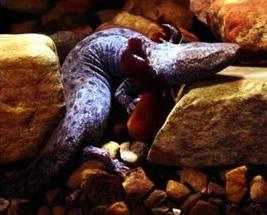The Terrestrial, Purple-Pincher or Caribbean Hermit Crab (Coenobita clypeatus) makes an endearing pet. However, it may in a sense be “too hardy” for its own good. For example, crabs may live for years even when denied salt (marine) water and other basic needs, giving owners the false impression that all is well. Read More »
Category Archives: General Reptile & Amphibian Articles
Feed SubscriptionHabits and Husbandry of the New Caledonia Giant Gecko
Herp enthusiasts are not the only folks in awe of Rhacodactylus leachianus, largest of the world’s geckos. Local people refer to it as the “Devil in the Forest” because, uniquely among its relatives, it can produce loud, growling sounds. Today we’ll review what little is known about its life in the wild, and touch on captive care.

Description
At 14.5 inches, this is the largest of the geckos, but an even larger species may possibly still survive in New Zealand. It is stoutly built with loose skin and a short, blunt tail. In contrast to most geckos, there are claws on the toes and slight webbing between them, as well as a grasping pad on the underside of the tail. Read More »
Breeding the Green Iguana – Indoor and Outdoor Nest Sites – Part 2
Please see Part I of this article for notes on constructing a practical outdoor nesting area for Green Iguanas (Iguana iguana).
Nests with Underground Access
Some breeders (and commercial farms) prefer to provide an underground entranceway into the garbage can nest site (Please see Part I), which is more in keeping with the Green Iguana’s habit of constructing a nesting chamber at the end of a long tunnel. Read More »
Aqua Gloves – an Important Tool in the Fight against Salmonella and Mycobacteria
 Turtles have been much in the news as potential carriers of Salmonella, but many people do not realize that nearly any creature, including dogs and cats, can transmit the bacteria. Less well-known are the potential health problems posed by Micobacteria, many species of which thrive in aquariums housing fishes, amphibians, reptiles and/or invertebrates. Coralife Aqua Gloves are an excellent safety measure for those times when your hands must be submerged in aquarium or aqua-terrarium water. Read More »
Turtles have been much in the news as potential carriers of Salmonella, but many people do not realize that nearly any creature, including dogs and cats, can transmit the bacteria. Less well-known are the potential health problems posed by Micobacteria, many species of which thrive in aquariums housing fishes, amphibians, reptiles and/or invertebrates. Coralife Aqua Gloves are an excellent safety measure for those times when your hands must be submerged in aquarium or aqua-terrarium water. Read More »
The Chuckwalla – a Hardy, Personable Candidate for the Desert Terrarium – Part 2
 Please see Part I of this article for more on the natural history of North America’s second largest lizard, the Chuckwalla (Sauromalus obesus).
Please see Part I of this article for more on the natural history of North America’s second largest lizard, the Chuckwalla (Sauromalus obesus).
Status in the Wild
Population levels appear stable as their preferred habitat is largely unsuitable for development. The species S. varius, however, is limited in distribution to 3 islands in the Gulf of California and is listed on CITES Appendix I. Read More »
 That Reptile Blog – Reptile, Amphibian and Exotic Pet Care and Information
That Reptile Blog – Reptile, Amphibian and Exotic Pet Care and Information
